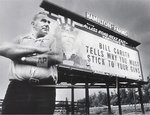
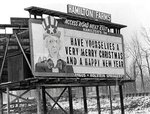
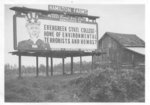
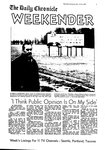
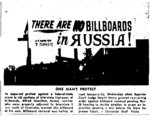


The Hamilton sign. Loved and hated. A bona fide piece of Lewis County history, it has become a part of the very fabric of local folklore. Both revered for its spirit and hated for its reputation (check out the Yelp reviews), nearly everyone has an opinion about the infamous billboard. Some say it’s a point of Lewis County pride — a certifiable landmark. Others say it hinders Lewis County’s economic interests and opportunities.
The Hamilton sign has been around longer than I’ve been alive. But I remember talking about the Hamilton sign in our social studies classes and hearing stories from other locals about Alfred Hamilton through the years. I know that Hamilton drew inspiration for some of his messages from the John Birch Society, as stated by Hamilton in a 1985 article in The Oregonian.
Often, when people talk about the Hamilton sign — and the state, federal and legal controversy surrounding it in the 1960s and ’70s — they talk about how the Hamiltons won their legal battle against WSDOT because of “free speech.”
But what if I told you that free speech was only part of it? That the legal nuts and bolts are much more fascinating and complex than that? According to the state Court of Appeals in their 1980 State v. Hamilton opinion:
“... our Supreme Court held it is constitutionally permissible for the Scenic Vistas Act to prohibit billboards visible from the highways which solely convey the owner’s own political or social beliefs, while allowing the exceptional signs listed in RCW 47.42.040(1)-(3).”
That’s a constitutionally permissible limit on property rights and free speech. That’s partially why we don’t see many signs like the Hamilton sign anymore.
Alfred and Ruth Hamilton owned a 200-acre farm adjacent to Interstate 5. As a way of making money, Al Hamilton used to lease billboard space on his property — seven billboards, at one point, according archived reporting. The Scenic Vistas Act took effect in the ’70s, which limited the number and types of billboard activities that were permissible, per parcel, on land adjacent to highways.
Hamilton erected his “Uncle Sam” billboard as a form of political protest to this action. The sign would move several times as the Hamiltons played a protracted game of legal volleyball with the state.
As a bit of rabble rouser myself, I admire this about Alfred Hamilton. And, as someone who supported the John Birch Society, it’s not a surprise — nor hard to understand why — Hamilton objected to what he likely saw as government overreach and infringement of his property rights.
Slade Gorton and Washington state took the Hamiltons to court over the billboard. The state’s position was that, while RCW 47.42.040 did allow specifically for “advertising signs” — in this case an “on premises” advertising sign — that the Hamiltons’ sign could not be considered lawful under that statute because the primary purpose of the sign wasn’t advertising. The majority of the sign’s face was dedicated to “the owner’s own political or social beliefs.”
Long story short, based on that argument, both the late Judge Dale Nordquist and the state Court of Appeals ruled in Hamilton’s favor.
You see, the Hamiltons successfully argued that their sign did fall within the legal boundaries of RCW 47.42.040(3) as an on-premises sign for several reasons. The state opinion describes the sign as it appeared in the 1970s:
“The white readerboard has a blue border, and in the border is written along the top in white letters the words ‘Hamilton’s 7+,’ and on the bottom ‘Angus-Holstein Springers.’ … Mr. Hamilton indicated in his deposition that ‘7+’ is the registered brand for his livestock. Above each main rectangular signface is attached a much smaller sign saying ‘Access Road Next Exit’ above one surface, and ‘Access Road 2nd Exit’ above the other surface. Topping each signface is another small sign reading ‘Hamilton Farms.’”
The State Court of Appeals considered this substantial evidence that the sign was, in fact, an advertising sign, per the statute definition. Nothing in RCW 47.42.040 that regulates the amount or type of advertising content on an advertising billboard (outside of libel, etc.). Courts affirmed that there was no legal mechanism for the state to arbitrarily enforce a “primary purpose” rule if the Hamilton’s sign met the requirements for exemption, which it did.
Regardless of how or what the Hamilton’s put on their billboard to call attention to their products, it was still an “advertising sign.”
In closing, the court stated: “The real question is factual: Are activities conducted on the premises which are advertised by the sign? The trial court, both judge and jury, found upon substantial evidence that the sign actually and effectively serves that purpose.”
But what about now? Today?
Al Hamilton sold the farm to National Frozen Foods in 1995 (and died in 2004), so there was no longer farming activities to advertise. The Uncle Sam sign had it’s Hamilton Farms references removed. The lower text of the sign has been updated a few times since then — at one point “Hamilton Corner / R V Park & Ye Old Fishing Hole” (remember the U-Fish place?) to now just “Hamilton Corner,” the name on the parcel records. The taxpayer is registered as “Hamilton Corner 1, Llc” and a PO Box in Camas
Bottom line: Nothing on premises is advertised, as required to be covered under the RCW 47.42.040 section (3) exemption, the very statute the Hamilton family used as a legal defense.
So, if the billboard isn’t an advertising sign anymore — is it still legal? If “Hamilton Corner” isn’t an on-site, active business (or isn’t active off premises) — does it still meet the statute?
WSDOT has inquired with the State Attorney General’s Office to find out.
Mr. Hamilton once told The Oregonian: “I’m not trying to convert anyone to my way of thinking. But I want to make people think.” And, at least in that regard, it seems Mr. Hamilton and I might have some common ground where the endeavors of our hearts are concerned.
•••
Brittany Voie is The Chronicle’s senior media developer. She welcomes correspondence from the community by email at bvoie@chronline.com.